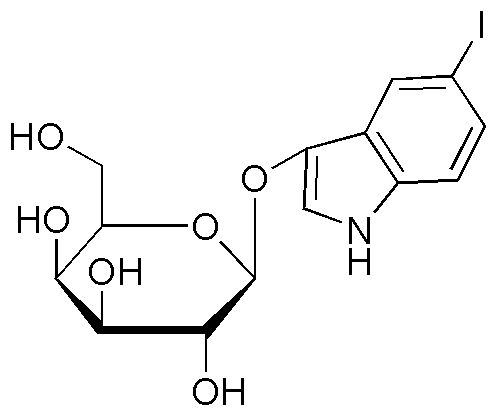5-Iodo-3-indoxyl-b-D-galactopyranoside is widely utilized in research focused on:
- Enzyme Substrate Development: This compound serves as a substrate for various enzymes, particularly in the study of glycosylation processes, allowing researchers to investigate enzyme activity and specificity.
- Histochemical Staining: It is employed in histochemistry for visualizing enzyme activity in tissue samples, providing a clear indication of the presence of specific enzymes, which is crucial in pathology and biological research.
- Biochemical Assays: The compound is used in biochemical assays to measure the activity of β-galactosidase, facilitating the study of gene expression and regulation in molecular biology.
- Drug Development: In pharmaceutical research, it aids in the screening of potential drug candidates that target glycosylation pathways, which are significant in various diseases, including cancer.
- Diagnostic Applications: This chemical can be utilized in developing diagnostic tools for detecting certain diseases by identifying specific enzyme activities in biological samples, enhancing early diagnosis and treatment strategies.
General Information
Properties
Safety and Regulations
Applications
5-Iodo-3-indoxyl-b-D-galactopyranoside is widely utilized in research focused on:
- Enzyme Substrate Development: This compound serves as a substrate for various enzymes, particularly in the study of glycosylation processes, allowing researchers to investigate enzyme activity and specificity.
- Histochemical Staining: It is employed in histochemistry for visualizing enzyme activity in tissue samples, providing a clear indication of the presence of specific enzymes, which is crucial in pathology and biological research.
- Biochemical Assays: The compound is used in biochemical assays to measure the activity of β-galactosidase, facilitating the study of gene expression and regulation in molecular biology.
- Drug Development: In pharmaceutical research, it aids in the screening of potential drug candidates that target glycosylation pathways, which are significant in various diseases, including cancer.
- Diagnostic Applications: This chemical can be utilized in developing diagnostic tools for detecting certain diseases by identifying specific enzyme activities in biological samples, enhancing early diagnosis and treatment strategies.
Documents
Safety Data Sheets (SDS)
The SDS provides comprehensive safety information on handling, storage, and disposal of the product.
Product Specification (PS)
The PS provides a comprehensive breakdown of the product’s properties, including chemical composition, physical state, purity, and storage requirements. It also details acceptable quality ranges and the product's intended applications.
Certificates of Analysis (COA)
Search for Certificates of Analysis (COA) by entering the products Lot Number. Lot and Batch Numbers can be found on a product’s label following the words ‘Lot’ or ‘Batch’.
*Catalog Number
*Lot Number
Certificates Of Origin (COO)
This COO confirms the country where the product was manufactured, and also details the materials and components used in it and whether it is derived from natural, synthetic, or other specific sources. This certificate may be required for customs, trade, and regulatory compliance.
*Catalog Number
*Lot Number
Safety Data Sheets (SDS)
The SDS provides comprehensive safety information on handling, storage, and disposal of the product.
DownloadProduct Specification (PS)
The PS provides a comprehensive breakdown of the product’s properties, including chemical composition, physical state, purity, and storage requirements. It also details acceptable quality ranges and the product's intended applications.
DownloadCertificates of Analysis (COA)
Search for Certificates of Analysis (COA) by entering the products Lot Number. Lot and Batch Numbers can be found on a product’s label following the words ‘Lot’ or ‘Batch’.
*Catalog Number
*Lot Number
Certificates Of Origin (COO)
This COO confirms the country where the product was manufactured, and also details the materials and components used in it and whether it is derived from natural, synthetic, or other specific sources. This certificate may be required for customs, trade, and regulatory compliance.


